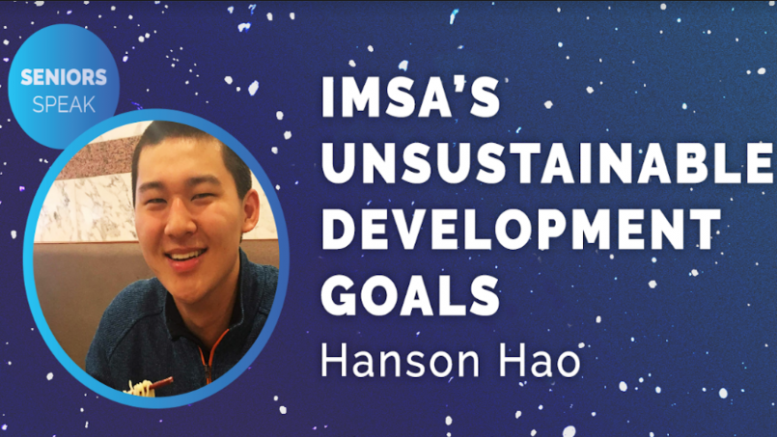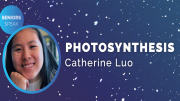One of the sections included in the annual Senior Edition is a series of essays titled Seniors Speak. These works are written and submitted to The Acronym by members of the graduating class, allowing them to reflect on their experiences, share advice, and advocate for change. The writer of this piece is Hanson Hao (Stanford University ’23), who lived in 1504A for his senior year. Hanson played quiz bowl for all three years of IMSA and became nationally recognized for his prowess.
The IMSA community has been hearing a lot about the United Nations’ Sustainable Development Goals (UN SDGs), a collection of global objectives to be met by 2030, for about a year now—they’ve been in my mind ever since I found the 17 goals plastered onto a wall for the 2018 ISSF. While IMSA should be commended for its attempt to use the SDGs to push us towards globally relevant problem-solving, the merits of the SDGs, as currently implemented, are simply far outweighed by their drawbacks. Let’s focus on the two main shortcomings of IMSA’s usage of the SDGs: vagueness and a restriction of intellectual freedom.
- Vagueness
- Contrary to what was expected from their implementation, the UN SDGs do not give IMSA nor its classes a specific goal, because they are too vague. Goal #1, “End poverty in all its forms everywhere,” gives the IMSA student no specificity, only undefined blanket terms such as “poverty” and “all its forms.” Goal #3, “Ensure healthy lives and promote well-being for all at all ages,” leaves it up to the individual to determine the meanings of “healthy” and “well-being.” Neither are they measurable—for example, it is extremely difficult, almost impossible, to objectively quantify terms like “inclusivity” as in Goals 4, 8, 9, and 11. And it is a stretch to expect the UN, much less IMSA, to meet all 17 goals–such as reversing long-term natural processes like desertification, rebuilding the world’s largest cities to be sustainable, and completely revamping nations’ judicial standards–by the 2030 deadline, making them not attainable or realistic. In effect, the UN SDGs do not meet three to four out of the five criteria of a SMART goal, meaning that IMSA’s current implementation strategy (i.e. copying and using them verbatim with no adjustments) will not be feasible for an institution of scientific rigor.
- In particular, using these goals verbatim in classes is problematic in regards to grading. How are teachers meant to grade students in an objective manner on their progress towards problems that are not specific, nor measurable, nor attainable? Much revision is necessary before the SDGs can set the standard in the IMSA classroom.
- Restricted Intellectual Freedom
-
- Per its mission statement, IMSA exists to “nurture creative…minds.” As the best teachers understand, this is done by teaching technique, whether it be problem-solving or essay-writing, through a topic that interests their students. Some teachers even allow the students to control the overall direction of their class. This is what brings students to IMSA—the intellectual freedom to engage one’s interests as they see fit, as well as the ability to identify what they would like to pursue in the future and coming out feeling prepared to do so.
- All the teachers that I’ve talked to–one each from the core academic departments of math, English, science, and social studies–indicate that the administration pushes the SDGs into their curricula on levels ranging from “not required, but classes that do implement the SDGs are specifically lauded” to “required to implement the SDGs.” Mandatory classes such as MSI and LEAD require students’ projects to conform to some SDG. To take intellectual freedom away by requiring students to follow the UN SDG party line in their work contradicts what IMSA should be as an institute of higher education. In attempting to “solve” the SDGs in our classes, there is minimal learning being done as we hastily and haphazardly assemble vague Googled and Wikipedia-ed “solutions” that do not reflect legitimate knowledge of the processes behind global issues. Such a small return does not make up for the opportunity cost of time that could instead be used to deeply investigate our own interests, possibly in “non-applicable” fields such as pure mathematics or literature. Solving social issues is not the purpose of education, it is rather intellectual curiosity and rigor.
- The aforementioned opportunity cost also includes the time not spent developing students’ (the vast majority of which do not have the requisite skills nor years of working experience) technique to solve intellectual challenges—great ideas do not pop up in a vacuum. The more time students invest into attempting to solve problems that they are unequipped to solve, the less time they have to actually develop the tools to solve those problems.
- If IMSA really wishes to use some aspect of the SDGs in its institutional mission, then it would do better to use them as the focus of I-day research projects. Students passionate about those issues would be encouraged to work on them during that time, while class time would be returned to allowing the students to develop the necessary technique. It is detrimental, as we’ve discussed above, to require all students to work on some assigned SDG during class time, particularly for those who are not interested in that topic (or any of the SDGs, for that matter)—they will contribute much more to the corpus of human knowledge when their creativity is driven by passion, not force. By letting the natural mathematicians prove, the natural scientists experiment, the natural journalists write, and the natural entrepreneurs pitch, much more gets done.
In short, the SDGs are leading IMSA down a questionable path, ensuring that we will be running in idealistic circles instead of climbing the stairs of educational excellence and intellectual advancement.
I’d like to thank the IMSA Acronym for giving me the opportunity to write this. It’s wonderful that you continue this tradition for all the departing seniors every year.






Be the first to comment on "Seniors Speak: IMSA’s UNSustainable Development Goals"